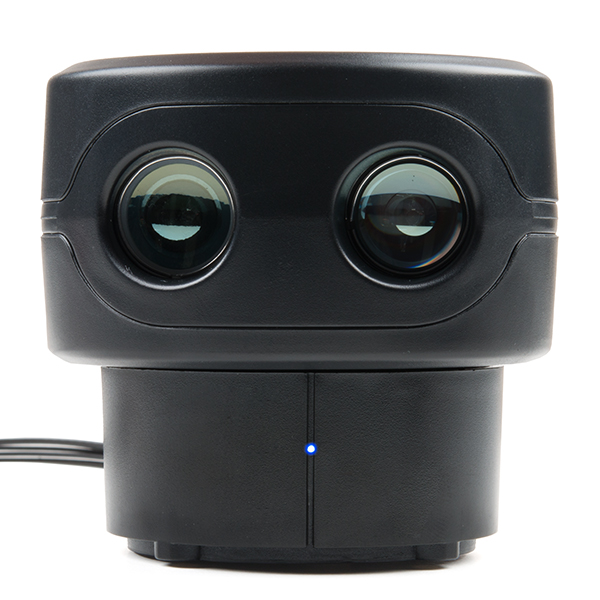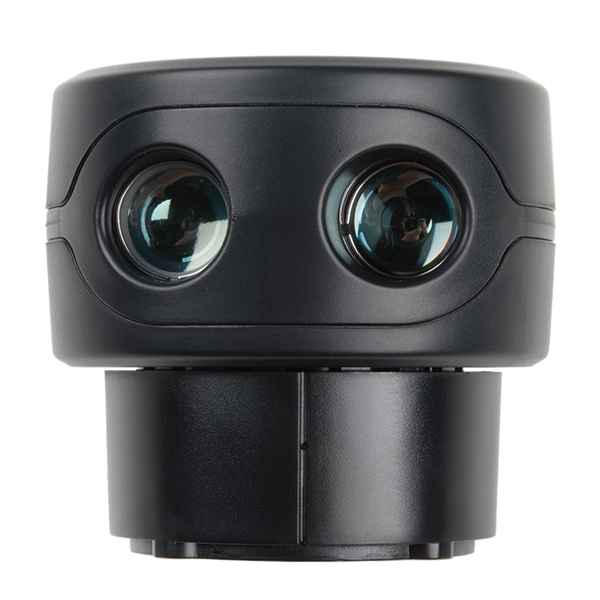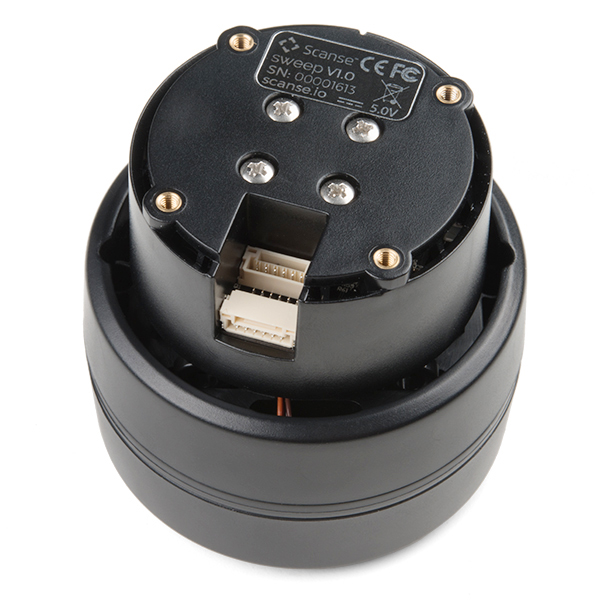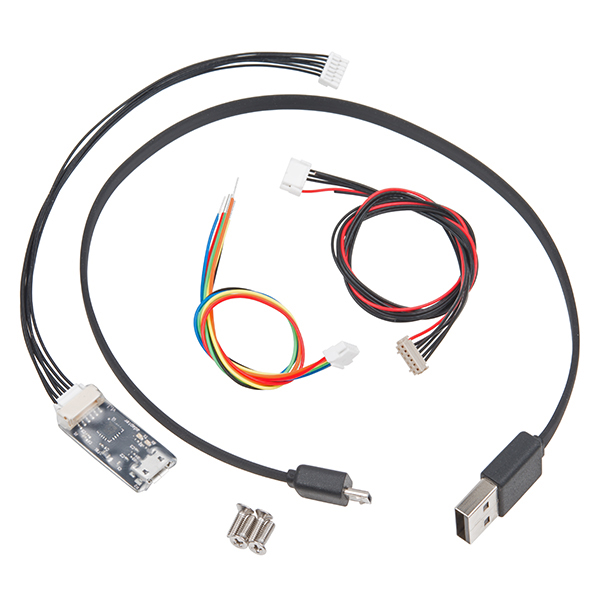Scanse Sweep
The Scanse Sweep is a scanning LIDAR sensor designed to bring powerful 360-degree sensing capabilities to everyone for an affordable price. With a built-in LIDAR-Lite, the Sweep possesses scanning capabilities that allow you to adjust the rotation speed on the fly so you can slow it down for more detail, or speed it up for faster reaction times! With a range of 40 meters, a sample rate of 1,000 samples/sec, the Scanse Sweep is a perfect sensor for Robotics, UAVs, site surveying, and Internet of Things (IoT)/security applications.
The Sweep is a single-plane scanner. This means that as its head rotates counterclockwise, it records data in a single plane. The beam starts out at approximately 12.7mm in diameter and expands by approximately 0.5 degrees. Sweep can be connected to low-level microcontrollers directly using its serial port, or to a PC using the provided USB-to-serial converter. It even has two serial port connectors with identical signals, which allows for more mounting options.
Note: This device contains a component which emits laser radiation. The laser product is designated Class 1 during all operating modes. This means that the laser is safe to look at with the unaided eye, however it is advisable to not look directly into the beam when in use. Operating the sensor without its optics or housing or making modifications to the housing can result in direct exposure to laser radiation and the risk of permanent eye damage.
- 1x Scanse Sweep
- 1x Serial Adapter Board
- 1x USB Cable
- 1x Sweep Cable
- 1x Sweep Pigtail Cable
- 1x Sweep Pixhawk Cable
- 4x Mounting Screw
- Range: 40m
- Resolution: 1cm
- Sample Rate: Up to 1075Hz (500Hz default)
- Field of View: 360°
- Rotation Frequency: 1--10Hz (Adj.)
- Interface: 3.3V (5V tolerant) UART TTL
- Power: 5V @ 450mA to 650ma
- USB Plug and Play
- Weight: 120 grams
- 65mm x 61.9mm
Scanse Sweep Product Help and Resources
Core Skill: DIY
Whether it's for assembling a kit, hacking an enclosure, or creating your own parts; the DIY skill is all about knowing how to use tools and the techniques associated with them.
Skill Level: Noob - Basic assembly is required. You may need to provide your own basic tools like a screwdriver, hammer or scissors. Power tools or custom parts are not required. Instructions will be included and easy to follow. Sewing may be required, but only with included patterns.
See all skill levels
Core Skill: Programming
If a board needs code or communicates somehow, you're going to need to know how to program or interface with it. The programming skill is all about communication and code.
Skill Level: Rookie - You will need a better fundamental understand of what code is, and how it works. You will be using beginner-level software and development tools like Arduino. You will be dealing directly with code, but numerous examples and libraries are available. Sensors or shields will communicate with serial or TTL.
See all skill levels
Core Skill: Electrical Prototyping
If it requires power, you need to know how much, what all the pins do, and how to hook it up. You may need to reference datasheets, schematics, and know the ins and outs of electronics.
Skill Level: Rookie - You may be required to know a bit more about the component, such as orientation, or how to hook it up, in addition to power requirements. You will need to understand polarized components.
See all skill levels
Comments
Looking for answers to technical questions?
We welcome your comments and suggestions below. However, if you are looking for solutions to technical questions please see our Technical Assistance page.
Customer Reviews
3.9 out of 5
Based on 7 ratings:
1 of 1 found this helpful:
Nice product.
It does what it claims to do. It's well built, well documented and easy to hookup.
You can, out of the box, plug it into your PC's USB and fire up the Visualizer app and see the data.
It's whisper quiet.
It does seem a bit delicate but it recovers from bumps and re-orientation (turn to side or upside down etc) no problem.
It works well with ROS .
The device seems to work well, but showed up dirty
I bought this brand new, but it looked like it was used. It had some kind of glue or something on top of the item and was dirty looking. It seems to work fine, but kind of annoying getting what looks like a used item.
exclente equipo
un gusto hacer negocios con ustedes todo lo que compramos resulto exactamente como lo esperábamos
0 of 1 found this helpful:
Barely works
It seems to operate really poorly with any setting. Just using sweep visualizer to test results are underwhelming and doesn't seem to match specs. Tried anyway with my bot in ROS and had issues again unusable sample rate is poor. I don't know if I have a bad unit -vibration some noise- but the neato 2d lidar has worked better than this... Wish I had tested it earlier and I would have returned it.
Well made
I tried the RPLIDAR product but didn't like it - noisy and a bit rickety. This scanner is better made. It's quiet and spins without vibration. I tried it first with the Scanse viewer on Mac to see what it could do. Now it's connected to, and powered by, a R-Pi3 via the USB-Serial adapter. It's under a lexan dome on a robot for obstacle avoidance. I compiled libsweep into my project from source, rather than build it as a shared object. I'm getting data from the Sweep but I'm still working on the best way to filter the data down to a simple, reliable obstacle indication. Overall - happy with it.
Works great
I bought this for my AVC entry. It is simple to get up and running and works really well.
In case anyone is interested, I wrote a Rust library for it (just a wrapper around the C SDK).
https://github.com/andygrove/libsweep-rs





I backed this project on Kickstarter and was lucky enough to get an early unit. Having used Hokuyo & SICK on a number of projects, I have to say that the ease of setup, cost, and performance all lived up to what was advertised.
-------------------- Tech Support Tips/Troubleshooting/Common Issues --------------------
Tutorials
Building the Spherical Sweep 3D Scanner [ https://www.hackster.io/scanse/sweep-3d-scanner-035a5f ]
Does this Lidar work outside? I know it says it could be used for drones, but I've used hokuyos in the past and certain models perform pretty poorly outside.
Good question - yes Sweep works well outside. It differs from many older scanning LiDAR sensors in that it sends out many micro pulses with a unique signature for each measurement. This unique code allows the sensor to more easily differentiate it's own light from ambient sunlight, which allows it to use a much lower power laser, and still achieve long range in noisy outdoor environments. This also allows our sensor to work well in environments with many other LiDAR sensors, without the risk of interference.
This looks similar to the scanner used by Neato Robotics vacuums. If the performance of my XV-21 is any indication, in many situations the proper application of SLAM should give good results. (Avoid thin or highly reflective obstacles.)
Unfortunately, too delicate for sensor embedded in robotics or drone flying. Correct for robot on gym floor or floor very smooth. The product does not tolerate impacts well. Excellent for topography and room scan. If you buy this product, be sure to be delicate. Good product.